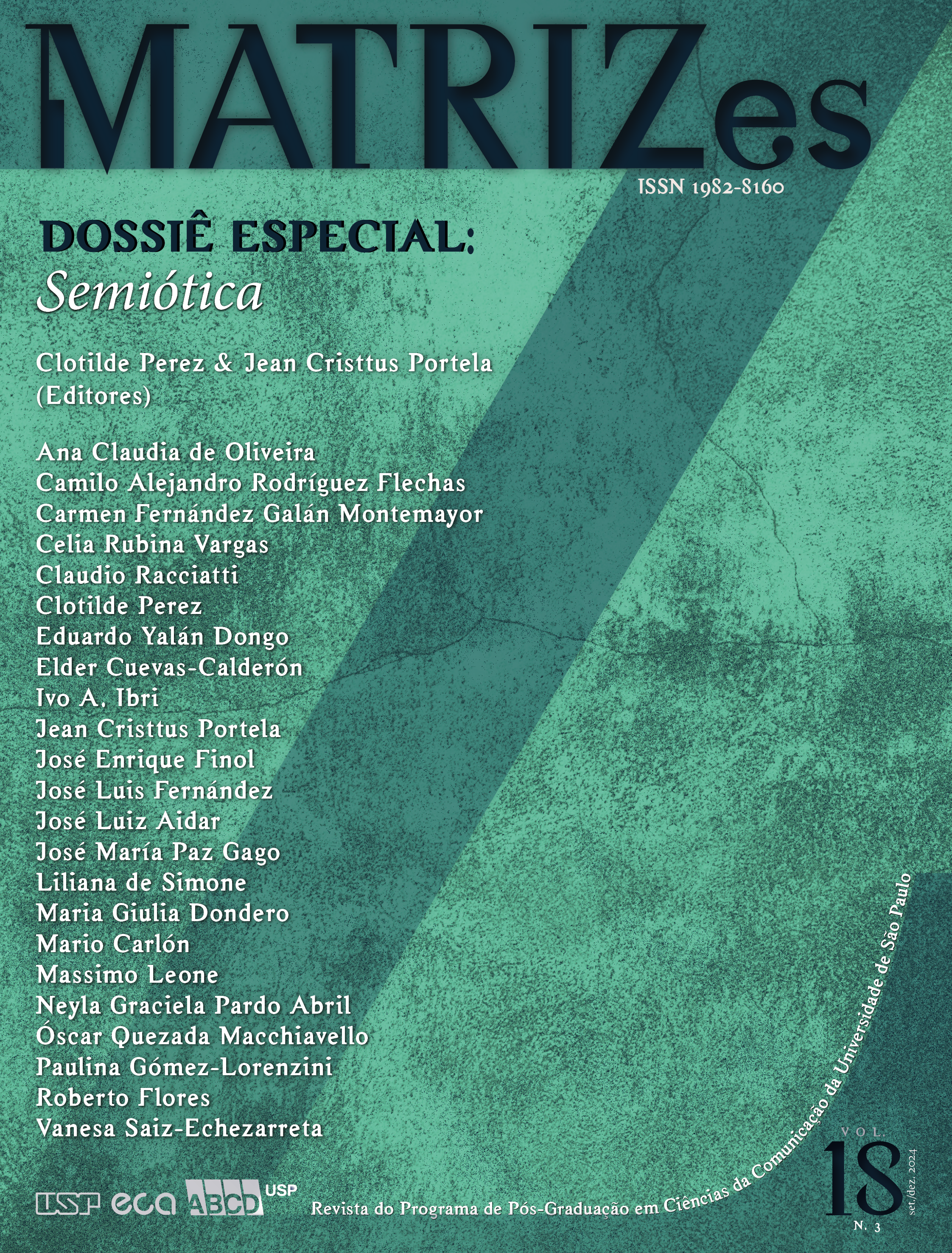Space-temporality and territoriality: Colombian internal forced displacement
DOI:
https://doi.org/10.11606/issn.1982-8160.v18i3p237-266Keywords:
Spatio-temporality, territory, forced displacement, internal armed conflict, Multimodal and Multimedia Critical Discourse Studies (MMCDS)Abstract
An analytical proposal is developed from the Multimodal and Multimedia Critical Discourse Studies (MMCDS) to address the spatial-temporal, territorial and memory relationship in the framework of representation of forced internal mobility in the Colombian armed conflict. The aim is to understand and interpret factors that determine the causes and consequences of forced internal mobility, making explicit the need to socialize knowledge about the social situation. The universe to be analyzed is the visual digital macro-narrative on the Truth Commission’s platform; the discursive sample is the interactive visual-graphic narrative, map, created by the Center for Spatial Research at Columbia University, through which the aim is to show how the representation of internal forced displacement is constructed between 1985 and 2021.
Downloads
References
Battistini, E., & Mondino, M. (2017). For a semiotic multisensorial analysis of urban space. The case of Ballaro and Vucciria markets in Palermo. Punctum, 3(1), 12-26. https://doi.org/10.18680/hss.2017.0003
Cañón, M. C. R. (2021, 28 de agosto). En el Pacífico caucano se reconfigura el conflicto armado tras la promesa de paz. El Espectador. https://www.elespectador.com/colombia/mas-regiones/en-el-pacifico-caucano-se-reconfigura-el-conflicto-armado-tras-la-promesa-de-paz/
Caquard, S., & Dimitrovas, S. (2017). Story Maps & Co. The state of the art of online narrative cartography. Mappemonde. Revue trimestrielle sur l’image géographique et les formes du territoire, (121). https://doi.org/10.4000/mappemonde.3304
Center for Spatial Research & Universidad de Los Andes. (2019). Conflict Urbanism: Colombia. https://conflicturbanismcolombia.com/
Colombia. (2016). Acuerdo Final para la Terminación del Conflicto y la Construcción de una Paz Estable y Duradera. Comisión de la Verdad. https://www.comisiondelaverdad.co/acuerdo-final-para-la-terminacion-del-conflicto-y-la-construccion-de-una-paz-estable-y-duradera
Comisión de la Verdad. (2020, 9 de diciembre). Yo soy la verdad [Video]. YouTube. https://www.youtube.com/watch?v=N4F2HaHEBTQ
Comisión de la Verdad. (2022a). Hay futuro si hay verdad: Informe final de la Comisión para el Esclarecimiento de la Verdad, la Convivencia y la no repetición. https://repositorio.iidh.ed.cr/items/80c1293f-d3f8-41ac-a9ad-02b95be6a3f1
Comisión de la Verdad (2022b). Desplazamiento forzado. https://www.comisiondelaverdad.co/violacion-derechos-humanos-y-derecho-internacional-humanitario/desplazamiento-forzado
Dane. (2022). La información del DANE en la toma de decisiones regionales. https://www.dane.gov.co/files/investigaciones/planes-departamentos-ciudades/220422-InfoDane-Cali-Valle-del-Cauca.pdf
De Certeau, M. (1996). La invención de lo cotidiano. Universidad Iberoamericana.
Entre enero y mayo de este año fueron víctimas de desplazamiento forzado cerca de 15.400 personas en Colombia. (2023, 31 de mayo). Defensoría del Pueblo. https://www.defensoria.gov.co/-/entre-enero-y-mayo-de-este-a%C3%B1o-fueron-v%C3%ADctimas-de-desplazamiento-forzado-cerca-de-15.400-personas-en-colombia
Halbwachs, M. (2004). La memoria colectiva. Universidad de Zaragoza.
Hernández, S. C., Rebolledo, J. E. R., & León, N. C. S. (2017). La restitución de tierras y territorios: Justificaciones, dilemas y estrategias. Dejusticia.
Internal Displacement Monitoring Centre. (2024). Global Report on Internal Displacement. https://api.internal-displacement.org/sites/default/files/publications/documents/IDMC-GRID-2024-Global-Report-on-Internal-Displacement.pdf
La restitución de tierras sigue estancada. (2024, 24 de abril). Fundación Forjando Futuros. https://www.forjandofuturos.org/la-restitucion-de-tierras-sigue-estancada/
Lefebvre, H. (2013). La producción del espacio. Capitán Swing.
Lewicka, M. (2008). Place attachment, place identity, and place memory: Restoring the forgotten city past. Journal of environmental psychology, 28(3), 209-231. https://doi.org/10.1016/j.jenvp.2008.02.001
Ley 1448 de 2011. (2011, 10 de junio). Por la cual se dictan medidas de atención, asistencia y reparación integral a las víctimas del conflicto armado interno y se dictan otras disposiciones. D.O. 48096. https://www.unidadvictimas.gov.co/sites/default/files/documentosbiblioteca/ley-1448-de-2011.pdf
Luque, R. (2016). Los desplazamientos humanos forzados recientes en el Cauca (Colombia): características e impactos sociales y espaciales. Investigaciones Geográficas, 65, 181-200.
Massey, D. (2005). For space. Sage.
Orianne, J. F., & Eustache, F. (2023). Collective memory: Between individual systems of consciousness and social systems. Frontiers in Psychology, 14, 1-14. https://doi.org/10.3389/fpsyg.2023.1238272
Pease, B., & Pease, A. (2008). The definitive book of body language: The hidden meaning behind people’s gestures and expressions. Bantam.
Pezzini, I. (2024). Devices for the representation and the spectacularisation of urban space: views, landscapes and logo-monuments. In F. Bellentani, M. Panico, & L. Yoka (Eds.), Semiotic Approaches to Urban Space (pp. 66-80). Edward Elgar Publishing.
Pierce, J. (2022). How can we share space? Ontologies of spatial pluralism in Lefebvre, Butler, and Massey. Space and Culture, 25(1), 20-32. https://doi.org/10.1177/1206331219863314
Reclamantes de la Hacienda Bellacruz logran tierras, pero no por restitución. (2024, 14 de febrero). Verdad Abierta. https://verdadabierta.com/reclamantes-de-la-hacienda-bellacruz-logran-tierras-pero-no-por-restitucion/
Registro Único de Víctimas. (2024). Unidad para las Víctimas. https://www.unidadvictimas.gov.co/es/registro-unico-de-victimas-ruv/37394
Santos, E. C. de los. (2020). ¿De qué hablamos cuando nos referimos a las movilidades forzadas? Una reflexión desde la realidad latinoamericana. Estudios Políticos, (57), 128-148. https://doi.org/10.17533/udea.espo.n57a07
Schloss, K. (2024). Color semantics in human cognition. Current Directions in Psychological Science, 33(1), 58-67. https://doi.org/10.1177/0963721423120818
Scollon, R. (2013). Geographies of discourse: Action across layered spaces. In I. De Saint-Georges & J-J. Weber (Eds.), Multilingualism and multimodality: Current Challenges for Educational Studies (pp. 183-198). Brill.
Téllez, J. F., & Balcells, L. (2022). Social Cohesion, Economic Security, and Forced Displacement in the Long-Run: Evidence from Rural Colombia. World Bank Group. https://documents1.worldbank.org/curated/en/099539304262234248/pdf/IDU015a9be2b0af470434608d7404a72dfd1d88a.pdf
Verberg, N., & Davis, C. (2011). Counter‐Memory Activism in the Aftermath of Tragedy: A Case Study of the Westray Families Group. Canadian Review of Sociology/Revue canadienne de sociologie, 48(1), 23-45. https://doi.org/10.1111/j.1755-618X.2011.01248.x
Winkler, J. R., Mengelkamp, C., & Appel, M. (2022). Real-time responses to stories: Linking valence shifts to post-exposure emotional flow and transportation. Communication Research Reports, 39(5), 237-247. https://doi.org/10.1080/08824096.2022.2119380
Downloads
Published
Issue
Section
License

This work is licensed under a Creative Commons Attribution-NonCommercial-ShareAlike 4.0 International License.
Authors who publish in this journal agree to the following terms:
- Authors retain the copyright and grant the journal the right to first publication, with the work simultaneously licensed under the Creative Commons Attribution License (CC BY-NC-SA 4.0) which allows sharing of the work with acknowledgment of authorship and initial publication in this journal for non-commercial purposes.
- Authors are authorized to assume additional contracts separately, for non-exclusive distribution of the version of the work published in this journal (eg, publishing in institutional repository or as a book chapter), with acknowledgment of authorship and initial publication in this journal.






















